When Motorola released the first-generation Defy in September 2010, it was an unusual proposition: an Android 2.2 handset that didn't totally skimp on specs but offered water, dust, and scratch resistance. You might remember that the ads for the phone made something of a splash when they were first shown, with it being dropped, drenched, and generally abused without showing so much as a scratch. Those commercials later got Motorola into hot water with the British advertising regulators as customers found their phones not quite living up to their hardened expectations.
A year later, and Motorola has released the Defy+ — a phone that on the outside looks remarkably similar to the original, down to the capacitive buttons, locking back, and camera, with an upgrade to Android 2.3 and a slight processor bump as the only notable spec increases. It’s also been handed the “lifeproof” moniker that the first-generation Defy introduced. But how does it shape up compared to its older brother?
Nothing much has changed over the original Defy, though Motorola has ditched the two-tone coloring, making the Defy+ only available in black. The candybar-styled handset is comfortable to hold, with a curved back aiding its ergonomics. A 3.7-inch display and capacitive buttons take up the majority of the Gorilla Glass face, with the earpiece and notification light above the display. The four buttons on the front panel are sensitive, respond quickly to touches, and lack any of the uncertainty we found with the similarly-specced Motorola Admiral. The power button sits up top next to the headphone socket — I found that it could be a little difficult to press at times, occasionally feeling as if it had clicked without any response from the phone.
On the right-hand side of the handset are the volume buttons, and on the left there's the Micro USB port. Water resistant flaps cover both the headphone socket and USB port, and around the back is the locking, water-sealed rear cover. On the reverse, you'll also find the noise-reduction microphone and a 5-megapixel camera with LED flash.
For a supposedly rugged phone, it doesn't feel all that well built
Make no bones about it, this handset is thick. In an era dominated by a race to be the thinnest among handsets like the Droid RAZR, Optimus Black, and Xperia Arc, which measure up between 0.28 inches and 0.36 inches, the Defy+ is unashamedly flabby at just over half an inch thick. Despite the girth, it sits comfortably in the hand, and nestles well in a pocket. Because of the all-plastic construction, it’s also light, weighing in at 4.1 ounces — less than any of the phones above.
In the box, besides the handset, you’ll get a miniature charger, a USB cable, and a wired stereo headset. The earbuds are very similar to the original iPod design, and while they fit okay, the sound quality is only average and they feel flimsy. I can’t imagine that anyone serious about audio would keep them for long, but for an included pair they do the job perfectly well.
One thing that did trouble me is that for a supposedly rugged phone, the Defy+ doesn’t feel all that well built. Squeeze the handset at the sides or between the back and face and there’s a noticeable creak and flex unlike most other phones available today. I put this build quality to the test — more on that later.
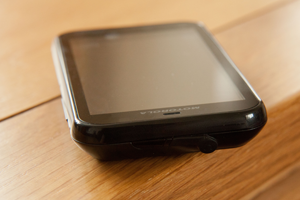
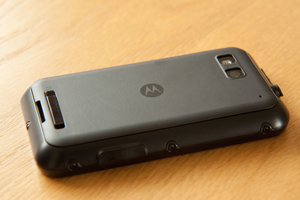

Display
Bright, crisp and clear, if a little on the small side


The Defy+ has a 3.7-inch, 854 x 480 LCD, which is bright, crisp, and easy to read. Although some larger screens might be reaching the 720p mark, with a panel this small, the relatively low resolution just isn't an issue. There's no pixelation to the naked eye, and text is easy to read. Colors are vibrant, with a good enough color depth that there's no noticeable stepping in gradients. The viewing angles are good, too — I have to look at the phone at least 60 degrees off-center before I notice the screen begin to wash out, by which point I'm struggling to differentiate letters anyway. While I'd prefer a slightly larger display, for its size the Defy+ doesn't do a bad job.
The touch sensitivity and alignment of the panel can be lacking at times, and I occasionally found myself struggling to hit buttons on the right edge of the screen accurately before the press was registered. These dead points become particularly annoying when you're trying to type a ‘P' or dismiss notifications from the tray. It's not consistent — sometimes it works perfectly, so it's difficult to work out whether this is a design flaw, a problem with my review unit, or something that can be solved in a software update. Despite it only occurring occasionally, it's highly frustrating when these things aren't flawless.
Update: We got in touch with Motorola about the screen sensitivity issue, and it said that it hadn't had any other reports of problems with the display. We swapped the handset for another Defy+, which was as responsive as you'd expect, and the defective unit has been returned for testing. Other issues like the creaky construction still remain.
Software

The software accounts for one of the biggest differences over the first-generation Defy, with the handset now running Android 2.3.4 over the original’s 2.2. As you’d expect, though, it’s wrapped in Motorola’s ever-present skin (formerly known as Blur), which is as heavy as usual and does the low-powered hardware no favors. Nearly all of Android has seen some degree of customization here, with a custom lock screen and apps. Generally we aren't fans of the skin, but I did find a few things to make it worthwhile.
Motorola includes some of the most comprehensive social integration I’ve seen on a device, letting you tie in everything from your Facebook and Twitter accounts to your Last.fm and LinkedIn profiles from one page. Despite this functionality, I found that the "Social Networking" app which ties it all together could get bogged down quite easily. The Motorola music app is fully-featured, with FM and internet radio, music videos from YouTube, TuneWiki, and SoundHound all built in. Blur also offers a handset security system — register on Motorola’s site and you’ll be able to remotely lock and wipe the device, and the phone will request a username and password whenever the SIM is changed or removed.
Pleasingly, the Defy+ is fairly light on third-party bloatware, with only CardioTrainer and QuickOffice preinstalled. There are also links to download music service 7Digital and magazine reader Zinio from the Market. While that’s great in terms of conserving the 1GB onboard storage available to users, the links can’t be removed, so even if you choose not to use them they’re stuck in your launcher permanently, and if you do install the apps you'll be unable to remove them from the device at all.
Pleasingly light on third-party bloatware, but it’s still a heavy skin


Camera
You won’t be buying the Defy+ based on its camera
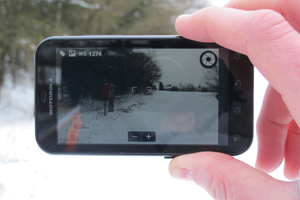


The camera app is sparse, with only a few scene modes and effects to choose from, along with very basic flash control. There’s a macro mode, and focus point selection (which I found could be hit and miss), but outside of that you’ve got to rely on the phone to make the decisions for you. The images produced by the 5-megapixel sensor are average for a phone — color reproduction is reasonably accurate if occasionally a little blue, and when you’re shooting a still object you’re likely to be pleased with the results. However, as soon as any movement is introduced into the photo, you’ll struggle. The shutter delay and lack of control over shutter speed combine to make blurry photos unavoidable, as shown by the photo of the reed in the wind in the gallery.
The low-light performance of the camera is patchy at best — while it focuses well, the background comes out noisy and ill-defined compared to objects that get the full brunt of the flash.
Video is sadly limited to VGA (640 x 480) despite the camera’s 5-megapixel sensor, though if you can look past the low resolution its performance isn’t terrible. The rear microphone handles sound-recording duties well, and there’s no hint of frame skip or judder.
Performance

Compared with some of the Android powerhouses we’ve reviewed in the past couple of months, in terms of specs the Defy+ is relatively feeble — a single-core 1GHz processor combined with 512MB of RAM. As a reference, this is nearly the same setup as on Google’s Nexus One, the flagship handset two years ago.
In day-to-day use, these low specs probably won’t be an issue, but you’re likely to find a degree of lag here and there that’s not present in other, more premium handsets. As mentioned before, there’s a delay in both the camera and social networking apps, both of which could well be down to the weight of Motorola's skin on top of the aging hardware. The low specs do have an upside — paired with a 1700mAh battery, the handset easily lasts for a day with moderate app use and web browsing without needing a charge.
There are a couple of performance areas where the Defy+ exceeds expectations. Firstly, the cell performance of the phone is nothing less than stellar. I live in a rural area around 25 miles from London, surrounded by large trees, which is a difficult environment for finding cellphone signal. I’ve never seen a phone so good at getting signal as the Defy+ — I've used a series of Nokias, Sony Ericssons, and iPhones, and the Defy+ is the first phone I’ve used that’s given me reliable signal everywhere in my house. Its speaker is also far fuller than I’d expected, and only suffers from tinniness at the very peak of its power. Don’t expect a huge amount of bass, but I’ve heard laptops with far worse sound than this.
Call quality is good, with the noise-cancelling mic performing admirably. Traffic noise is filtered well, though it struggled to truly cancel wind noise. People on the other end of the line said that they could hear me clearly, and the earpiece is loud, though it can sound a little sharp at times.
Despite the phone’s apparent signal strength (which more often than not was showing the HSDPA indicator rather than simply 3G) I found that the real-world data performance was mixed. While I could occasionally manage between 1.5Mbps and 2Mbps download speeds, results below 1Mbps were far more common. In everyday use, this might not be all that important, but you might find that the handset struggles with heavier applications like streaming video.
Cellular performance is nothing less than stellar

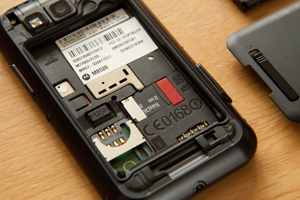
Resilience
Just how lifeproof can it be?

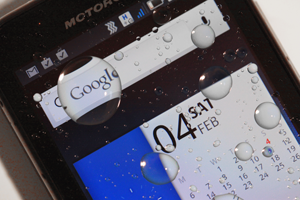

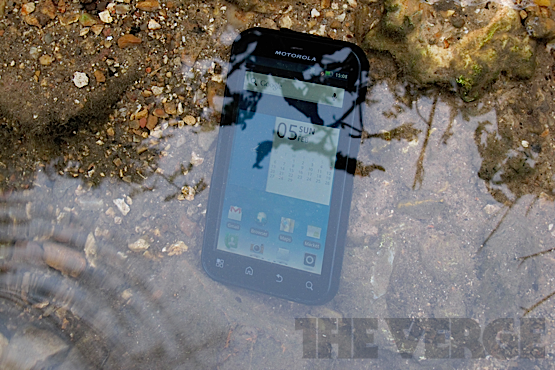
And now to the Defy+’s headline feature: how rugged is it? When the phone was announced, Motorola’s press release described the Defy+ as resistant to water, dust, and scratches to IP67 of the Ingress Protection standard, meaning water-resistant to depths of up to a meter and totally dust-resistant.
The Gorilla Glass screen is as hardy as we’ve come to expect, absorbing impacts and every attempt I made to scratch its surface. Even a couple of days spent in the same pocket as my keys left the device totally unscathed. Dust protection is a difficult one to test, but I certainly found nothing to complain about there. When it comes to water resistance, however, it seems Motorola hasn’t learned its lesson from the original Defy.
Taking baby steps, I tried the phone under the shower and the tap, before finally taking the plunge and fully submerging the device. Throughout these tests, it performed admirably and stayed functional (though not usable, as the water caused the capacitive screen to detect false presses). When I went to recharge the device, though, I found that not all was as well as it seemed, with the battery refusing to take a charge. Removing the back, I found droplets of water had leaked into the battery chamber — precisely the same problem that Chris Ziegler encountered when he reviewed the first-generation Defy. A night next to my hot water tank managed to dry the unit out, with the battery recovered and able to take a charge by morning.
The primary issue here is that there’s no way to tell whether the phone's back is properly attached. Despite my best efforts when assembling the Defy+, there’s no warning if the back cover isn’t forming a tight seal with the body of the handset, making any confidence you have in the phone's water resistance misplaced. The IP67 rating — most often applied to industrial applications like heavy-duty power connectors — feels overstated here.
It's not too defiant, but resists more than most handsets
I was pleasantly surprised by a number of things about the Defy+ — I found a lot of Motorola’s customizations to the software useful though a little weighty, and appreciated its heroic ability to find a network connection when all other phones around me are struggling. On the downside, with next to no changes over its predecessor, there’s very little reason here for even the most die-hard Defy fan to consider upgrading, and it's tough to strongly recommend a handset that doesn't live up to its claims about water resistance.
At around £220 (about $350) without a contract, the Defy+ could be a good value option for those looking for a smart handset that can stand up to a little more abuse than the average phone. However, if you're particularly worried about ruggedness, there are plenty of options on the market that can withstand more of a beating — like the Sonim XP1301 and Samsung's Solidextreme range. If you really want a rugged Android handset, there's also the Samsung Galaxy Xcover, which offers the same IP67 certification as the Defy+.
:format(webp)/cdn.vox-cdn.com/uploads/chorus_asset/file/12790369/Hed.1419965261.png)
:format(webp)/cdn.vox-cdn.com/uploads/chorus_asset/file/12790369/Hed.1419965261.png)
Share this story